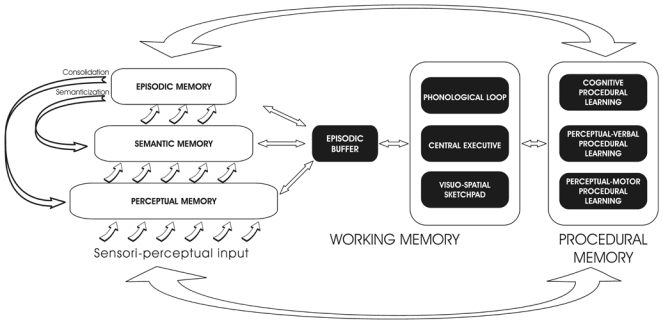Figure 2.

MNESIS (Memory NEoStructural Inter-Systemic model). This model, which comprises five memory systems, integrating the concepts developed by Tulving (1995 Tulving (2001) and Baddeley (2000), highlights relations between different systems in order to give account of the dynamic and reconstructive nature of human memory, with reference to the theories notably put forward by Conway (2001) and Schacter (1996).
Three long term representation systems (perceptual memory, semantic memory, episodic memory) are embedded in a hierarchical way, as in the SPI model elaborated by Tulving. However, MNESIS contains specific particularities. The term “perceptual memory” replaces the Perceptual Representation System, and thus includes both conscious and nonconscious operations. Furthermore, contrary to SPI, direct links between perceptual memory and episodic memory are possible, even if further studies are needed to clarify up to which point. In the same vein, MNESIS allows to take account of current “hot topics”, such as the concept of personal relevance to better characterize the interrelations between episodic and semantic memory. In MNESIS, the three long term representation systems are also connected by two (retroaction) arrows. The first one, going from episodic memory to semantic memory, designates the fundamental process of memory semanticization. The second arrow, going from episodic memory to perceptual memory, refers to the transfer of perceptual traces during the phenomenon of re-living experiences, that can be followed up by re-encoding in episodic memory and thus contributes to one form of memory consolidation. Overall, the organisation of the three long term representation systems together with the two interactions underlines the dynamic and reconstructive nature of memory. Working memory occupies a strategic position within the overall memory systems. The interactions between the episodic buffer and the central executive and episodic memory will form a key research topic over the coming years. Procedural memory is shown on the right-hand side of the model. MNESIS specifies the interactions (formulated by arrows) with the representation systems (including working memory) during the phase of procedural learning, these links subsequently weakening during the process of automation.
